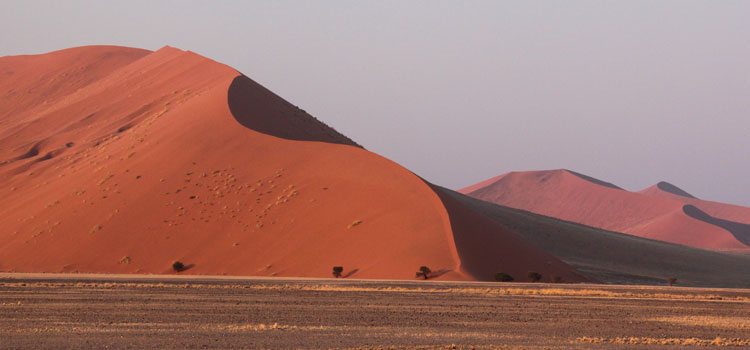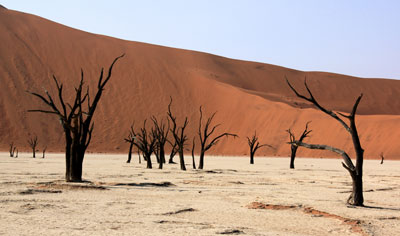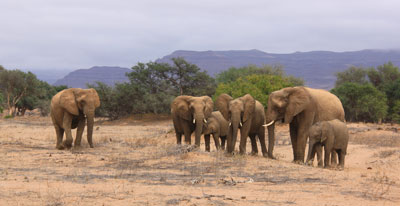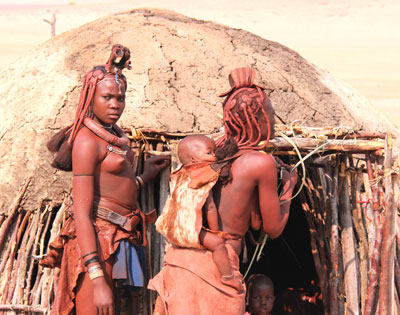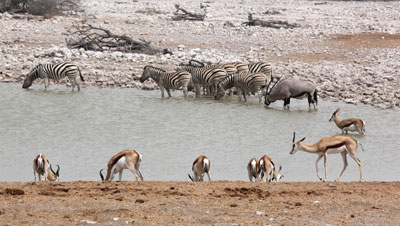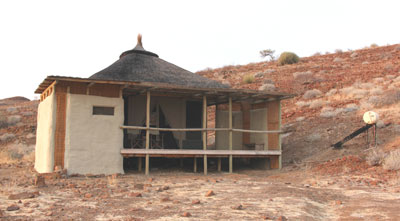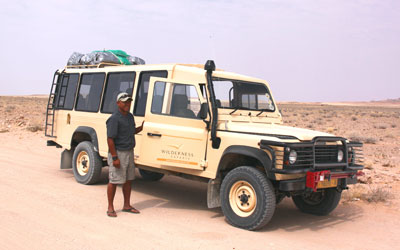The spectacular scenery of Namibia
Namibia may not be everyone’s idea of a safari country. It doesn’t have the variety, large herds or impressive migrations of animals one can experience in East Africa or Botswana. However, as my wife and I discovered in September ’10, Namibia impresses with spectacular scenery, wildlife that have adapted to the incredibly harsh desert environment, and the opportunity to meet native people little affected by the outside world.
by Bob Swope, Oro Valley, AZ
Namibia may not be everyone’s idea of a safari country. It doesn’t have the variety, large herds or impressive migrations of animals one can experience in East Africa or Botswana. However, as my wife and I discovered in September ’10, Namibia impresses with spectacular scenery, wildlife that have adapted to the incredibly harsh desert environment, and the opportunity to meet native people little affected by the outside world.
Planning the trip
Namibia is a large country — about the size of Arizona, New Mexico and Utah combined — but the population is estimated at only around two million, resulting in one of the lowest population densities in the world (roughly six persons per square mile). As we traveled through the country, we could sense the remoteness and isolation.
In planning our trip, we wanted to be sure that Wilderness Safaris would be our in-country tour operator. We had been on one of their small-group safaris in Botswana in 1994 and were impressed with the quality of their camps, guides, camp staff and the vehicles used as well as flawless logistics in a part of the world where tourism was still in its infancy.
Wilderness Safaris offers six small-group (eight people or less) trips in Namibia as well as customized trips. We particularly liked their “Great Namibian Journey,” a 13-day, mostly overland safari that covered most of the highlights of the country.
We found Bert du Plessis of Fish Eagle Safaris (Houston, TX; 800/513-5222), who specializes in Southern and East Africa and works primarily with Wilderness Safaris. Bert not only booked the “Great Namibian Journey” for us but made recommendations and booked pre- and post-safari hotels in Johannesburg and Windhoek.
Bert also works with an airline consolidator, who was able to find reasonably priced ($1,950 per person) round-trip flights from Tucson to Washington, DC (with United Airlines), and on to Windhoek via Johannesburg on South African Airlines. The transatlantic SAA flights were definitely long (17 hours), but the service was far superior to that of any of the domestic airlines on which we’ve flown.
Getting settled
Bert recommended the 80-room Peermont Metcourt Suites (phone +27 11 557 0555) for our overnight near the Johannesburg Airport. It was a short 10-minute complimentary shuttle ride from the airport; shuttles run every 20 minutes in either direction.
The rooms were contemporary, clean, quiet and reasonably priced ($180, including a full buffet breakfast). The real plus, however, was that this hotel, as part of the Emperors Palace Hotel Casino Convention Resort, had a food court, one modeled after that of The Venetian in Las Vegas. Good choices included African, Portuguese/Angolan, Indian, Greek, seafood and pizza restaurants.
A second overnight was spent at the elegant, 11-room Olive Grove Guesthouse (phone+264 61 239 199) in Windhoek. This was a wonderful place to stay. The large staff was helpful and friendly; the rooms were comfortable without being fancy or fussy; the atmosphere was peaceful, and there was a small, excellent restaurant with seating on the front veranda and pool deck — a real plus, since it is recommended that guests take a taxi after dark to and from any of the nearby restaurants.
The room rate was $355 per night, including the transfer to and from the airport 25 miles outside of town. Dinners cost about $25 each.
On to Sossusvlei
Ricky Averia, our outstanding Wilderness Safaris guide, picked us up at the Olive Grove the next morning. We joined six other group members, all from England.
Our vehicle for the next nine days was an extended Land Rover Defender. It comfortably held 10 passengers, so everyone had a window seat. In addition, there was a pop-up roof, allowing for more photo opportunities, plus a small refrigerator that kept bottled water cool.
Our bags were strapped on top of the rig and covered with a tarp, which was a good thing, as we generated a lot of dust on the gravel roads.
The beauty of an African overland road trip is that you really see the country — its towns and villages, vibrant marketplaces, the spectacular geology and unique vegetation as well as its animals, up close. The downsides that one needs to think about when considering such a trip, however, are the distances traveled and the sometimes less-than-ideal road conditions.
A normal travel day between camps on the “Great Namibian Journey” was roughly 200 miles (six hours), mostly on roads that were gravel or sand and rutted, but our Land Rover was comfortable enough and handled the road conditions impressively. Ricky’s sense of humor and our compatible group members made the long days an enjoyable and memorable experience.
Our first destination was Sossusvlei, world famous for its towering red/gold sand dunes, some as high as 1,000 feet. Only two of the dunes are currently “open” to visit and climb. Dunes, however, surround the area, and the early-morning and late-afternoon light make for exceptional photos.
Don’t miss the opportunity to hike to Deadvlei, a salt pan in the middle of the dunes with standing trees that have been carbon-dated back 600 to 900 years.
Expect to share this area with other visitors. We saw more people here than anywhere else on the safari. Ricky said that several hundred people visit each day during the high season (April through October).
One of the advantages of traveling with Wilderness Safaris is that they have been able to develop and manage small camps in isolated, pristine areas because of the concession areas that have been granted to them by the government. They have three such camps in the Kulala Wilderness Reserve adjacent to Sossusvlei, including the Kulala Desert Lodge, where we stayed.
The lodge had 19 thatch-roofed canvas tents on raised wooden platforms with attached bathrooms; individual verandas overlooked a dry riverbed and water hole. With ceiling fans, the tents were quite comfortable during the warm nights.
As at all of the camps we visited, the staff was a friendly and happy group. One night, they sang and danced for (and eventually with) the guests in the dining room.
Swakopmund
After a full day exploring the natural beauty of Sossusvlei, we drove on to Swakopmund, a distinctly German-influenced town of 42,000 along the South Atlantic coast. This small town was developed as a port to rival nearby Walvis Bay, a former British outpost.
Along the way, we stopped in the very small settlement of Solitaire, known for its bakery and the apple pie that Moose McGregor has been making since 1992 — well worth the stop in the middle of nowhere!
We stayed at the four-star Hansa Hotel in Swakopmund, a beautiful building dating from 1905. The rooms encircled an inner courtyard of grass, palm trees and other vegetation that seemed to be thriving in the unique marine climate. Excellent meals, especially the buffet breakfasts, were prepared in the hotel kitchen.
Ricky took the group to dinner at The Tug Restaurant along the waterfront one night. Excellent local fish such as kingklip is served in a friendly environment.
The next day was stormy and blustery as we explored Walvis Bay. On board a small open fishing boat, we saw plenty of Cape fur seals, Haviside’s dolphins and pelicans. The captain offered “Namibian coffee” (sherry) to keep us warm.
The highlight of the day, however, was the four-wheel-drive exploration of the dunes near Sandwich Harbour. Our drivers (brothers Zack and Nico) followed faint tracks in the sand, taking us up and down the dunes like a roller coaster ride. After all of that heart-pounding excitement, they found a secluded and protected hollow in the dunes for a sit-down, white-tablecloth, seafood-and-champagne lunch.
Damaraland
The next day’s drive took us away from the coast and deep into Damaraland in northwest Namibia. In another scenic Wilderness Safaris concession area is Damaraland Camp, with 10 tent-like structures with attached bathrooms. Warm water for bathing was provided by solar water heaters.
The bathrooms had several openings to the outside which would be perfect in warmer times; unfortunately, the nighttime temperature was unseasonably low. Blankets and hot-water bottles in our beds were a welcome surprise.
Meals here — and at all of the camps — included tasty game meat such as oryx and impala.
We saw lots of wildlife at Damaraland as well as at our next destination, the eight-tent Desert Rhino Camp, located farther north in the private Palmwag concession area. Sightings included oryx, springbok, ostrich, Hartmann’s mountain zebra, giraffe, kudu and elephant. As the name implies, Rhino Camp is known for its rare, desert-adapted black rhino.
Wilderness Safaris is a major supporter of the Save the Rhino Trust. As a result, Wilderness Safaris’ guests are allowed to accompany Save the Rhino trackers.
We followed the trackers by vehicle and foot for several hours before spotting a lone male resting in the shade. The trackers allowed us to approach to about 150 yards, but we had to remain hunkered down and could stay for no more than about 10 minutes to avoid stressing the animal. It was an exciting moment for all of us and proof that the reintroduction program is having success.
Over lunch in a nearby dry riverbed, the trackers showed us a photo book that they had compiled of the roughly 30 rhinos known to be in the area, including “our” Ben.
Etosha and Ongava
After one night at Damaraland Camp and two nights at Rhino Camp, we moved on to Etosha National Park in the north-central part of the country. Etosha is deservedly the most well-known animal park in Namibia.
We saw much larger herds here than elsewhere congregated around the numerous water holes, including two large prides of lions.
Here, Wilderness Safaris again had a choice location for its camps. The Ongava private concession area/game reserve is situated along the southern boundary of Etosha. (The access road to Ongava is just outside the main Andersson Gate into the park.) The boundary between the park and the reserve is unfenced, allowing for the movement of large game between the two areas.
We stayed at the Ongava Tented Camp, consisting of 10 tents on raised wooden platforms with attached bathrooms and both indoor and outdoor showers. The highlight of the camp was the deck that stretched from the dining area and bar and overlooked an active water hole. Only a decorative wooden fence along the deck separated us from the animals.
The camp staff videotaped the overnight visitors, and every morning guests could check on the animal activity that went on while we all slept. It was quite telling that after nightfall guests were escorted back to their tents by armed staff members.
The Skeleton Coast
We said good-bye to our trusty Land Rover and flew from a small airstrip at Ongava to the Skeleton Coast Park Research Camp. The flight was operated by Sefofane Air Charters. The Cessna Caravan held 13 passengers, and the two-hour flight was both scenic and smooth.
The Skeleton Coast Park is named for the numerous shipwrecks that lie off the treacherous shores and the many skeletal remains of whales that washed up on the beaches. We were met by the camp manager, who explained that, like anything that survives in this harsh, arid environment, we also would have to adapt by limiting our water usage. Sink water was rationed through the use of a bucket that was filled daily.
Because of the typical early-morning/late-afternoon fog — generated by the clash between the icy Atlantic Ocean and the warm desert air and which drifted inland by as much as 30 miles — the solar heaters could not promise much hot water.
The six-tent camp was definitely more basic than the others at which we’d stayed, but the friendliness of the staff (they welcomed visits to the kitchen, remembered each group member’s favorite drink, and sang and danced in celebration of the birthday of one of our fellow group members) and the sheer beauty of our surroundings more than made up for any hardships.
We spent almost three days exploring this most remote and inhospitable area, made especially isolated by the lack of roads, the national park restrictions and the exclusivity of the private concession area managed by Wilderness Safaris. In the days we were there, we never saw any other visitors.
Coming from Arizona, we knew something about desert wilderness, but the Skeleton Coast is almost beyond description — gravel plains, rugged mountains, towering canyons, dry riverbeds, impenetrable sand dunes, expansive vistas and even bigger skies.
Ricky followed tracks in the gravel but because of sifting sands had difficulty getting up and over some of the dunes. On several occasions we had to lighten the load by climbing the dunes on foot, and we always held on tight as the vehicle steeply descended.
Interesting excursions
Two particularly noteworthy excursions took us to the Cape Fria seal colony and a Himba village.
Thousands of seals inhabit the Cape. As far as the eye could see, there were seals sleeping, swimming, grooming, communicating and fighting. Black-backed jackals, brown hyenas and vultures hovered around the edge of the colony, picking off the sick, the very young and the unwary. It was a fascinating sight but only for so long, as the aroma of so many seals eventually became overwhelming.
The Himba people reside primarily in this area of Namibia. Because these seminomadic pastoralists are so isolated, they are only now being affected by the outside world. Thus far, they have been able, in large part, to keep to their traditional ways.
We saw mostly women in the village, as the men were out with their goat and cattle herds. The women are known for covering their skin with a mixture of red ochre and butter fat, which protects them from the sun and gives them a distinctive rich red appearance. Their hair, covered with the same mixture, is styled in intricate patterns.
The village was comprised of six to eight huts surrounded by a tree-limb fence. We were invited into the homes but discouraged from walking between the animal corral and the holy fire in the middle of the village.
The women make jewelry (including some particularly interesting bracelets out of PVC pipe material) and other carved-wood trinkets to earn cash. Like the nomadic pastoralists of East Africa, the Himba move their villages from water hole to water hole from one season to the next.
On our departure day, the coastal fog was exceptionally dense and lasted well into the afternoon. As a result, our charter plane had to land on a gravel strip in the settlement of Purros, an hour inland from our camp. We returned to “civilization” in Windhoek after about 2½ hours.
Practical matters
The total cost for our 13-day “Great Namibian Journey” was $12,800, which included all accommodations; meals; drinks; exclusive guide services; park fees; internal airfare; laundry service at specified camps, and taxes. Our international airfare and pre- and post-safari hotels, as previously mentioned, cost extra. CSA travel insurance cost $948.
Based on suggestions provided by Wilderness Safaris, we tipped our guide between $20 and $25 per day and the camp staff $10 a day. Tips were welcomed in South African rand, Namibian dollars, euros or US dollars.
We needed cash in remote areas in order to purchase souvenirs. Credit cards were accepted at the hotels and restaurants in Johannesburg and Windhoek.
Except at those camps with limited water (Damaraland and Skeleton Coast) and at the Hansa Hotel, laundry service was included in our safari cost. As a result, we were able to limit the amount of clothes we packed.
Because of the small size of the charter planes, each of us was limited to one soft-sided duffel bag weighing no more than 26 pounds. To make sure we were within that limit, we packed a separate bag of pre- and post-safari clothes and left it in storage at the Olive Grove Guesthouse while on safari.
At each camp, we were able to recharge our digital camera batteries. I simply gave the camp staff my charger, battery and a three-prong South African plug adapter (purchased from Magellan’s; 800/962-4943) at the end of the day and they returned my fully recharged battery to me in the morning. It worked like a charm!
We used 1.25-gallon zip-lock plastic Hefty bags to keep the camera dust free.
Summing up
Namibia is a great destination for a second or third visit to Africa. In addition to its having friendly people and incredible scenery, one marvels at how animals have survived in such a harsh, unforgiving environment.
The tourist infrastructure is well established, expanding to serve an increasing number of visitors and impressive in its quality of service, as was evidenced by our experience with Wilderness Safaris. It all made for a wonderful, memorable trip.

